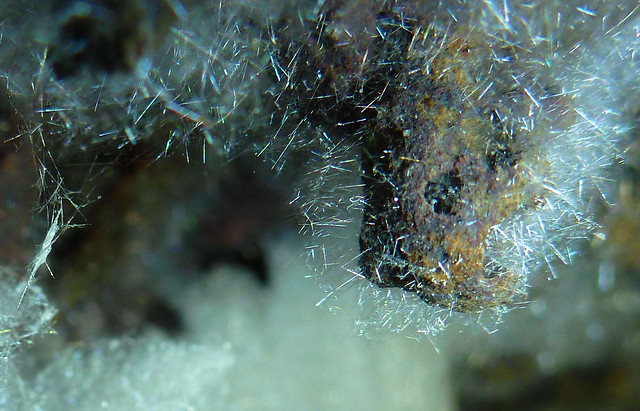The Gypsum is what is known as a "secondary" formation, i.e. it is formed some time after the formation of the cave, unlike lava stalagmites and stalactites that form as the cave is forming. I think Menacer is right, in that the Gypsum is deposited from water leaching through the rock that the cave is formed in and dissolving it. In principal this is little different to calcite formations in a limestone cave. Such secondary formation are relatively common in lava tubes, and though Gypsum seems to be the most common mineral they can be formed from many others (I have seen calcite, silicates and opal to name a few).
The deep drifts of dust, almost like snow, I have only seen on Lanzarote. These can be really deep, as shown by the "snow" crater in the picture below.
I have also caved in lava caves in Iceland, Sicily, Mexico and Korea (as well as Tenerife and El Hierro which also lie in the Canaries archipelago) and seen many gypsum formations but not the fine dust. The formation of the dust is not something I know about. However, there are some clues in some of the caves. In some caves on the island there are rather beautiful and delicate gypsum flowers;
And in at least one other there are some very fine crystalline filaments coating the walls (the cave also has masses of the white dust). I suspect (though do not know) that the dust is somehow formed by breakdown of these formations. It is also possible that there is at least some biological factors involved in its formation.
As to the draughts. Strong draughts are present in many of the Lanzarote caves, but apart from a few constricted passages I have not seen them strong enough to blow the dust about (in some of the constrictions the wind speed is high enough to kick dust into your eyes). As to eruptions causing the equivalent of speleological gales, I am not convinced of this. I would suspect that any temperature effects would be very limited in area, and if the cave entrance(s) were that close to an eruption subsequent to that in which the cave was formed I think that it would be very likely that the entrance would be blocked by ash, tephra or even newer lava flows (I have seen evidence of this from inside at least one cave in Iceland). In practice it seems rare that a lava tube is subjected to harsh volcanic conditions post its formation without it being destroyed (as some caves on Hekla were some years back).
I have to add that I am supposing as much as anyone else in this debate, all my knowledge is second-hand from someone who knew far more than me about this subject, but is alas not able to educate me any further. I think that this white powder on Lanzarote is fascinating, and I would suggest that Paolo Forti (co-author of cave minerals of the world) or Diana Northup (
http://www.caveslime.org/) may well be best placed to give definitive advice - or sponsor some research!







